Chapter 2
VoIP: Not Your Father’s Telephone Service
In This Chapter
![]() Uncovering the origins of VoIP
Uncovering the origins of VoIP
![]() Telephoning using analog lines
Telephoning using analog lines
![]() Going digital
Going digital
![]() Networking analog and digital
Networking analog and digital
![]() Digitizing the public telephone network
Digitizing the public telephone network
![]() Raging war between circuits and packets
Raging war between circuits and packets
![]() Replacing POTS phone systems with VoIP
Replacing POTS phone systems with VoIP
![]() Discovering how private telephone systems reduce POTS costs
Discovering how private telephone systems reduce POTS costs
![]() Watching network types multiply and morph
Watching network types multiply and morph
Voice over IP represents a significant change from the traditional way that telephone calls have been handled until recently. Even so, the genesis of VoIP is rooted in the history of networks, specifically, the history of the circuit-switched phone network.
This chapter explores just a bit of that history. It offers a whirlwind tour of how phone systems got to where they are today and how that relates to VoIP. By understanding the way that phone networks relate to things such as regulated phone costs, you’ll find it easier to grasp the huge cost savings that can be realized by converting to VoIP.
Mr. Bell
Believe it or not, the roots of VoIP go all the way back to the 1870s. In 1879, Alexander Graham Bell forgot his Internet password and, knowing that his assistant had stashed it away, uttered the famous words “Watson! Are you there?” He never got on the Internet, but he did prove that the human voice could be carried electronically over a pair of wires. He also demonstrated that the endpoints for these wires had to be connected to the right equipment — hardware that he invented. Mr. Bell’s inventions ushered in an age of communication that made the world much smaller than it had ever been before.
When Mr. Bell invented the telephone and thereby gave birth to the telephone network, VoIP was not even a consideration. (Truth be told, the idea of a network wasn’t yet a consideration either.) Other inventions would be required before VoIP could become a reality.
The first telephone equipment was analog. Historians and technicians alike have labeled the first phone service POTS , or plain old telephone service. VoIP won’t function very well over a POTS system; it requires a digital network.
Digital networking for telephones was invented in the 1920s, but the first digital networks would not leave the laboratory until much later, in 1964. Today, most phone companies in the United States have updated their equipment to include digital service.
Over time, the POTS network gave way to the PSTN, or public switched telephone network. (The terms PSTN, public switched telephone network, public telephone network, and phone network are used synonymously.)
Although it occurred in what seems like the ancient past, Alexander Graham Bell’s work is important in understanding VoIP. The POTS network that began with his invention has grown into the largest circuit-switched network in the world. It also has become an expensive network, with individuals and companies spending hundreds of billions of dollars each year for communication services.
VoIP, which was developed in 1995, is gradually replacing the PSTN. Some view the PSTN as the antithesis of VoIP, but it still remains the standard of quality by which VoIP is measured. For instance, people often ask whether VoIP provides voice quality as good as what is delivered through the PSTN. Most of the factors used to evaluate the quality of VoIP are based in some way on the PSTN, so understanding a bit about the older networks is important.
Analog Telephone Circuits
As mentioned, phone technology originally was analog, from start to finish. Analog modulation is the technique used to convert sounds (such as your voice) into an electromagnetic form. The analog circuitry of the POTS telephone transmitter converts the voice patterns coming from the caller’s mouth into continuous electromagnetic signal patterns. These patterns are carried on a telephone line circuit, sometimes called a trunk line, where they are carried to the terminating end of the circuit. There, analog circuitry converts the signal back into audible sounds so they can be understood by humans.
A good basic illustration of a POTS circuit can be found in an old elementary school science experiment. My fifth-grade science teacher, Ms. Davis, had us punch a hole into the end of two tin cans and connect them using a long string. If we held the string taut, Jodie Schnickmeister could whisper into one can and I could hear her in the other. (I used to love it when Jodie whispered in my ear.)
This simplistic experiment taught the basics of the POTS network: Sound was converted to an analog signal (vibrations) that was carried over the taut string to the receiving can. The string, in turn, vibrated the can and converted the analog signal back into audible sounds.
Telephony Goes Digital
Scientists, never content with two tin cans and a string, looked for different ways to transmit sounds over long distances. The pioneering work of Harry Nyquist in the 1920s gave us the basics of sampling theorem. In the 1940s, Claude Shannon would mathematically prove Nyquist’s sampling theorem. Their work is the foundation for what we now call digital networking. Basically, they proved that you could take the analog signals of any POTS call and convert them to digital form. This meant that POTS calls could originate in analog form, be converted to digital form, and be transmitted on the PSTN using the now familiar ones and zeroes of computers. Digital networking had arrived, setting the stage for the beginning of VoIP.
The work of Nyquist and Shannon led to many telephone and computer network inventions. For example, Nyquist is credited with the patent that led to the first coder-decoder, or codec, device. Codecs can come in many sizes and shapes and are often found in the electronic circuitry of large networking devices. Codecs basically convert analog signals to digital form and vice- versa. Nyquist’s work led to the design of many other networking devices such as dial-up modems, high-speed broadband modems, IP routers, and VoIP gateway servers.
The ability to convert analog signals to digital form also led to the development of several types of computer networks. From the early 1960s to the present day, several types of digital networks, including fiber-optic-based networks and wireless networks, have emerged in support of computers and telephone systems. Today’s digital networks, regardless of the form they take, are capable of supporting VoIP telephony. We cover network types beginning in Chapter 4.
Combining Analog and Digital
When digital networks were introduced, the phone companies wanted to use them right away because they provided a more efficient means of transmitting signals all over the place. (Digital networks could carry data much faster than analog networks.) The phone companies were presented with a problem, however: how to make existing analog phones work with a digital network.
The answer was to use a codec to convert the analog signal to digital. But where should the conversion take place? At the phone company’s facilities or at their customer’s location? In the early years of the digital revolution, the conversion took place at the phone company’s facilities, which allowed the phone company to utilize the existing wiring between their facilities and the customer’s location. This wiring between a phone company facility and a customer is often called a local loop.
Over the years, the codec has been pushed closer and closer to the customer, all in an effort to make the phone network as close to 100 percent digital as possible. Most parts of the PSTN remain a combination of analog and digital. Customers pick up a phone, which converts audible sound into analog signals. These signals are carried over the local loop to the phone carrier’s facilities, where they are converted to a digital signal. The signals are forwarded to the receiver’s end. After the signals are received by the last piece of carrier equipment (closest to the end customer), they are converted back to analog form. The analog signals go into the receiver side of the POTS telephone and are heard as a replica of the caller’s voice. Figure 2-1 illustrates how a phone call is transmitted over the PSTN.
Calling Pennsylvania 6-5000
In the 1940s, a consortium of leaders in the telecommunications industry and in government standardized how customers would be assigned telephone numbers. The telephone number identified a specific pair of wires out of millions of pairs of wires, and a specific phone company switch out of thousands of such devices. The term circuit-switched describes this setup of circuit wiring, switching devices, and telephone number assignment. The PSTN is sometimes referred to as the circuit-switched or switched network.
Because today’s public phone system is still circuit-switched, it still relies on the same basic system for telephone number assignment. VoIP introduced dramatic changes in how the network is used and, over time, VoIP could force changes in how numbers are assigned. With VoIP, phone numbers are no longer tied to specific wires and switches. VoIP routes calls based on network addresses, and phone numbers are simply used because that is what people are familiar with. (VoIP takes care of translating a phone number into a network address.) In the future, as more and more people adopt VoIP-based systems, we may see dramatic changes in phone numbering.
|
Figure 2-1: A typical PSTN telephone connection. |
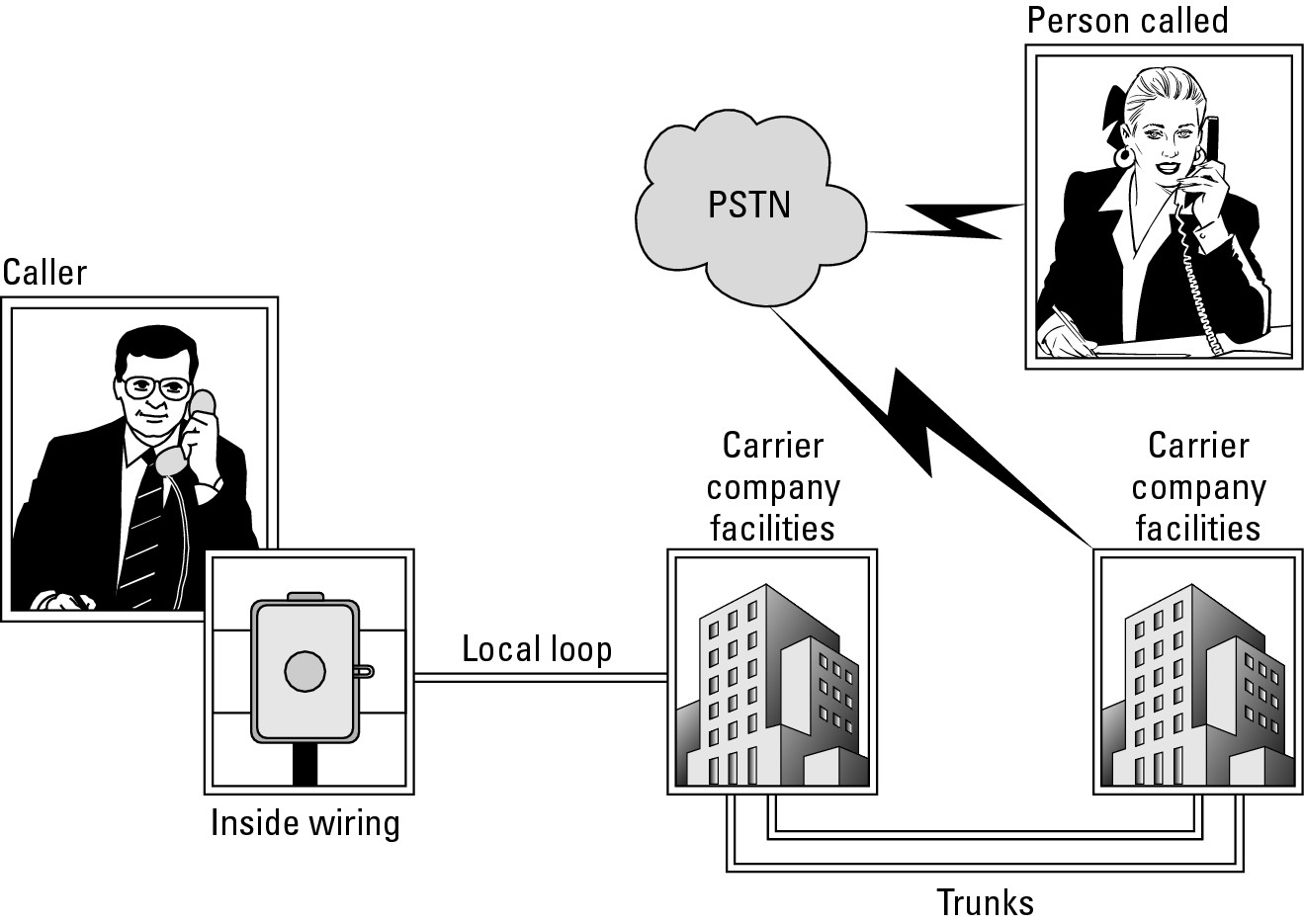
|
Today, a customer can have either an analog or a digital phone. Depending on customer location and end-user equipment, the POTS call can be 100 percent digital.
For more than a century, POTS remained the dominant form of two-way telecommunications. During that time, however, POTS-based telephone systems changed dramatically in the number, length, diameter, and type of wire or cables used and in the types of telephone equipment both at the customer end and at the carrier’s facilities.
Digital Telephony Invades PSTN Territory
When digital networks were implemented back in the 1960s, the telephone carrier companies began using a technique that permitted them to accept analog telephone calls coming into their switching facilities and convert those signals into digital form for transmission on their shiny new networks. They had not yet made the leap into packetizing telephone calls, which is what we have today with VoIP. At the time, they thought it best to keep the circuit-switched telephone carrier network physically separate from the evolving packet-switched computer network.
The phone companies were able to make other improvements to circuit-switched telephone services. After their circuit-switched carrier network received the caller’s telephony signals, they were able to convert the signals into digital form, as necessary. They discovered that digital signals allowed them to aggregate many more calls onto a given circuit and through a given switch than they could before. This enabled them to streamline how circuit-switched telephone calls could be made.
One innovation was the addition of area codes, which help to process calls over a circuit-switched network. The entire telephone number, including area code, identifies the number of circuits and the location of the switching devices for a given phone on the PSTN network. For example, consider a call originating in Mountain View, California (area code 415) to a person in Pittsburgh, Pennsylvania (area code 412). The call is switched out over three physically distinct circuit switches — 415 to 412 — to set up and carry the call. Figure 2-2 illustrates the routing of such a circuit-switched call.
|
Figure 2-2: Routing a call from area code 415 to area code 412. |
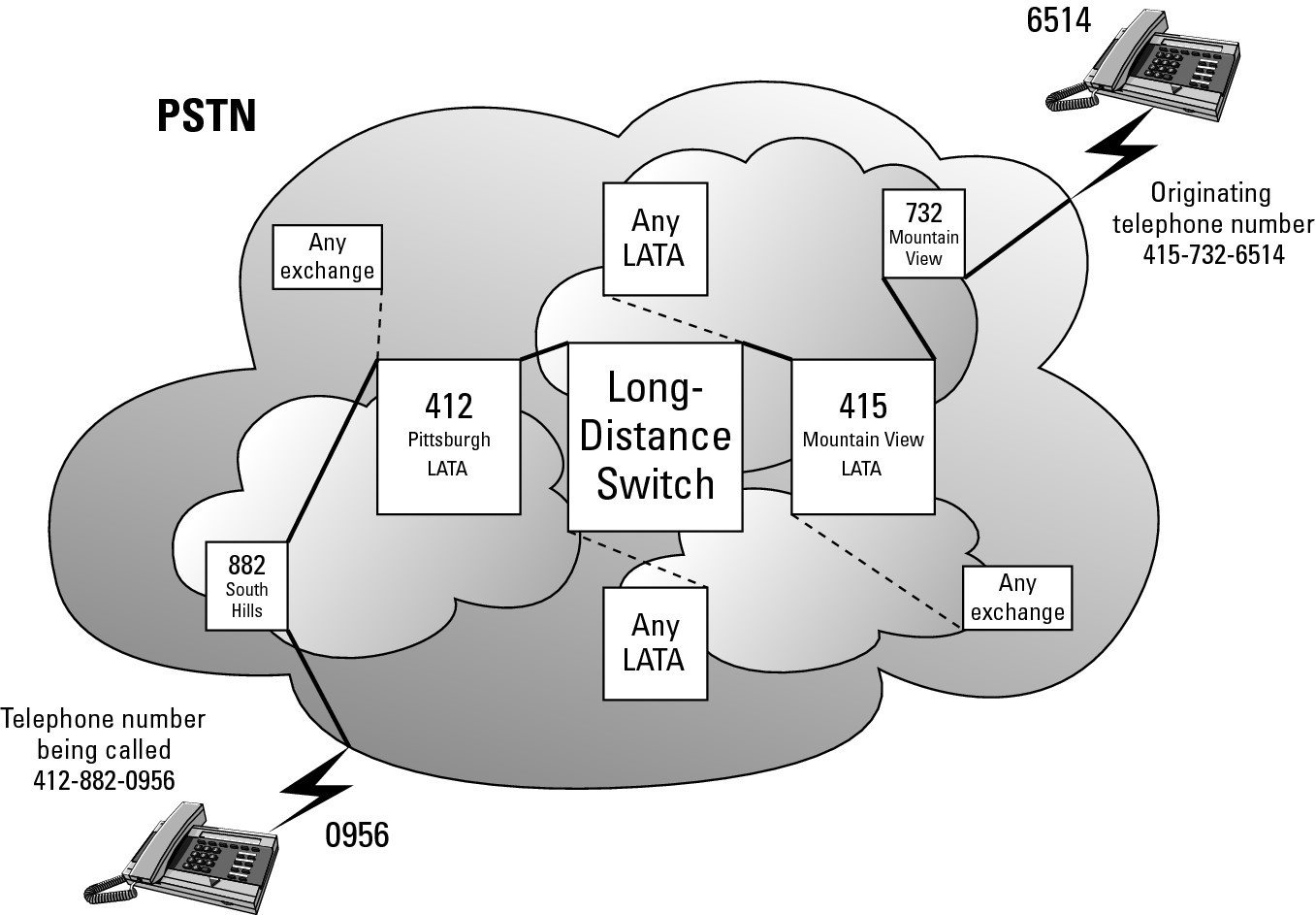
|
If these two locations are on the same computer network, and both are using VoIP, the call could be carried over the company’s computer network in packet form. This process is known as on-net VoIP telephony. None of the packets would touch the PSTN. There would be no toll, regulatory, or metered charges for this long-distance telephone call. Figure 2-3 illustrates the routing of such a packet-switched VoIP call.
|
Figure 2-3: Routing a call across a VoIP network. |

|
The circuit-switched network gets organized
As circuit-switched networks continued to evolve, other technologies were developed that helped the carriers manage their telephony operations. Carriers began offering more types of POTS access and POTS carrier services.
The early forms of local and long-distance carrier services had to be redefined according to where the carrier company had facilities to terminate the circuits and transport lines, as well as where they might install their facilities. In addition, government regulation of telecommunications picked up. The concept of a local access and transport area, or LATA, as a geographical designation was defined. Eventually, the entire map of the United States would be developed into thousands of LATAs. You can usually identify a particular LATA by the area code associated with a telephone number.
The big advance with LATA was that it helped carriers get organized in a manner that would let them offer other types of carrier services, including those outside the circuit-switched services of the PSTN. For example, a numbering plan was developed that identified any circuit or access transport by its area code and the prefix of the main telephone number. The area code became known as the NPA, for numbering plan area, and the prefix became known as the NXX, for number exchange. For example, the NPA-NXX 412-882 is the area code and prefix for the Pittsburgh 412 LATA and switch 882, located in the South Hills of the Pittsburgh 412 LATA.
What does the NPA-NXX number have to do with VoIP? In Chapter 7, I discuss dedicated networks that have proven to be the highest quality of service (QoS) network type for VoIP networks. All carrier lines for a dedicated VoIP network are priced using the NPA-NXX of each location included in the network.
Following the development of digital services, the corporate sector began demanding more bandwidth from carriers to support their networks. It didn’t take long for carrier companies to develop digital, high-bandwidth transport lines that could meet the diverse needs of the corporate sector.
These newer transport lines would be digital all the way from a customer’s location A to the same customer’s location B, regardless of how many miles were in between. These customer demands led to the development of transport services that multiplied exponentially the amount of available digital bandwidth that could be offered to the corporate sector.
These newer ultrahigh-bandwidth transports were not the same kinds of wires as those in the POTS network. They were usually a thicker-gauge wire or fiber-optic cables. When installed, they connected two or more locations of a customer’s company in a point-to-point fashion versus the circuit-switched method of the PSTN.
These developments contributed to the emergence of private dedicated networks, which in turn ensured that VoIP would be here to stay. (As you find out in later chapters, VoIP becomes a viable option for companies only when used over dedicated networks.) Eventually, on-net VoIP over dedicated networks will replace expensive circuit-switched calling over the PSTN.
The digital services carrier network
The new types of digital lines installed by the carriers began to form a new physical carrier services network. The lines did not cross-connect or intersect with any of the millions of circuit-switched lines that are in place and continue to be installed by the carriers. At the carrier company’s facilities, newer types of fully digital equipment terminated these digital lines.
This new carrier services network was called the digital services carrier network. (It is also known as the digital signal carrier network, or simply as the DS .) This network used higher-bandwidth digital lines and operated with packet-switched protocols to network computer data. (For more on protocols, which are simply rules for using the network, see Chapter 1.)
Soon thereafter, the DS network was defined based on its fundamental unit of bandwidth, known as the channel. The smallest channel unit provided a bandwidth of 64 Kbps (64 thousand bits per second). This channel was called a DS0, pronounced “D–S–zero.” (Many computer gurus start counting with 0; it’s a binary thing.) DS0 became the base unit of bandwidth from which other dedicated transports were defined. (In Chapter 7, I cover the popular DS standards in detail.)
The DS network also introduced to the telecommunications vocabulary another term that characterizes most of the transport mechanisms that are not part of the older circuit-switched network. Because the lines used by the DS carriers were installed between private customer locations and the public at large could not use or connect to them, DS lines became known as dedicated to the customer leasing them. The entire series of DS standards eventually became known as the dedicated carrier services network.
War Breaks Out Between Circuits and Packets
The corporate sector’s thirst for leasing dedicated DS lines was unquenchable. Soon a dilemma emerged as to how to distinguish the circuit-switched network and the newer dedicated network, which used packet-switching technology. Since its inception, the circuit-switched network was a public carrier services network. The DS network was being called dedicated, or private, because no one but the customer paying for the DS lines was permitted to use them.
Public versus private a.k.a.
Confused over the different terms for the PSTN and dedicated networks? The following list comes to the rescue, showing the most popular also-known-as terms for both.
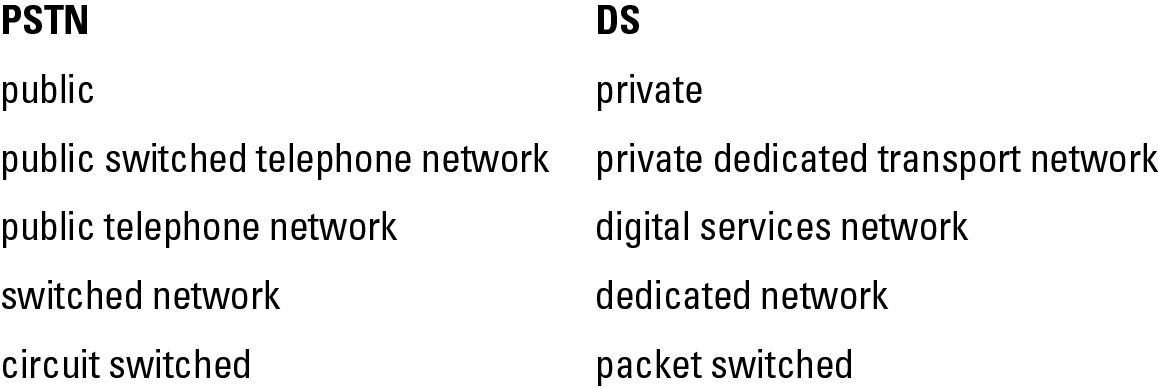
It wasn’t a great leap to make the distinction between public and private types of services. At this point, the name public switched telephone network (PSTN) began to be used to characterize the circuit-switched network. Eventually, the PSTN would be referred to by the telecommunications industry as simply the switched network. The DS name stuck with the network that provided private dedicated transport services. Eventually, the DS network would be referred to as simply the dedicated network.
Figure 2-4 illustrates the physically separate PSTN and DS networks.
POTS telephony continues to use circuit-switched protocols that don’t packetize telephony signals. (See Chapter 1 for an explanation of packets.) POTS signals travel from one line to the next line on a given circuit of lines, just like in the fifth-grade science experiment using tin cans and a string. Another good way to understand circuit-switched protocols is to think about a railroad system. Trains must switch tracks along a circuit of tracks based on the destination of the railroad cars traveling over the tracks. The direction of the train is determined by the physical tracks that the train uses. Figure 2-5 illustrates such a circuit-switched train.
|
Figure 2-4: Noncon-verged PSTN and DS networks. |

|
|
Figure 2-5: The circuit-switched network is like a train traveling on physical tracks. |
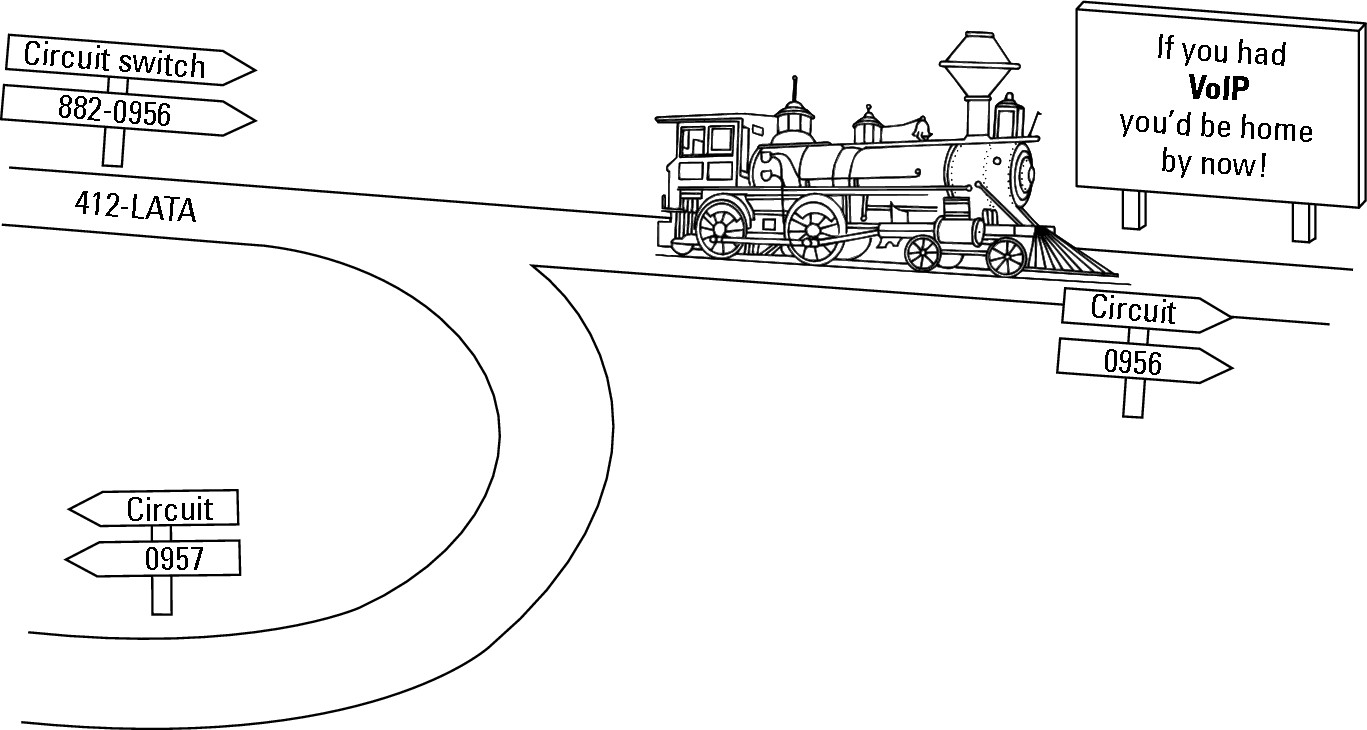
|
VoIP technology has enabled telephony signals to run over dedicated networks using packet-switched protocols. One of the preferred methods of running VoIP in the corporate sector is to use dedicated lines. Instead of being primarily dependent on the PSTN for its telephone service requirements, companies using VoIP protocols can send and receive telephone calls over their private computer networks. Using VoIP, voice signals can be packetized in a manner similar to computer data packets.
VoIP includes the caller and receiver’s network addressing information in the packets sent over the network. If a given circuit on the network is down, VoIP packets can switch to another computer network circuit because the packet is not dependent on the circuit itself for directions. In the previous example, the circuit-switched train is switched solely by the tracks it travels. If the train runs into a broken track, it can’t continue to travel to its destination. VoIP packets can have many alternative routes because the destination address inside the packet tells the network where to route the packet.
Most companies today use packet-switched networks for their computers and separate circuit-switched networks for their voice calls. Figure 2-6 depicts this typical scenario.
|
Figure 2-6: Companies typically use noninte-grated networks for data and voice. |
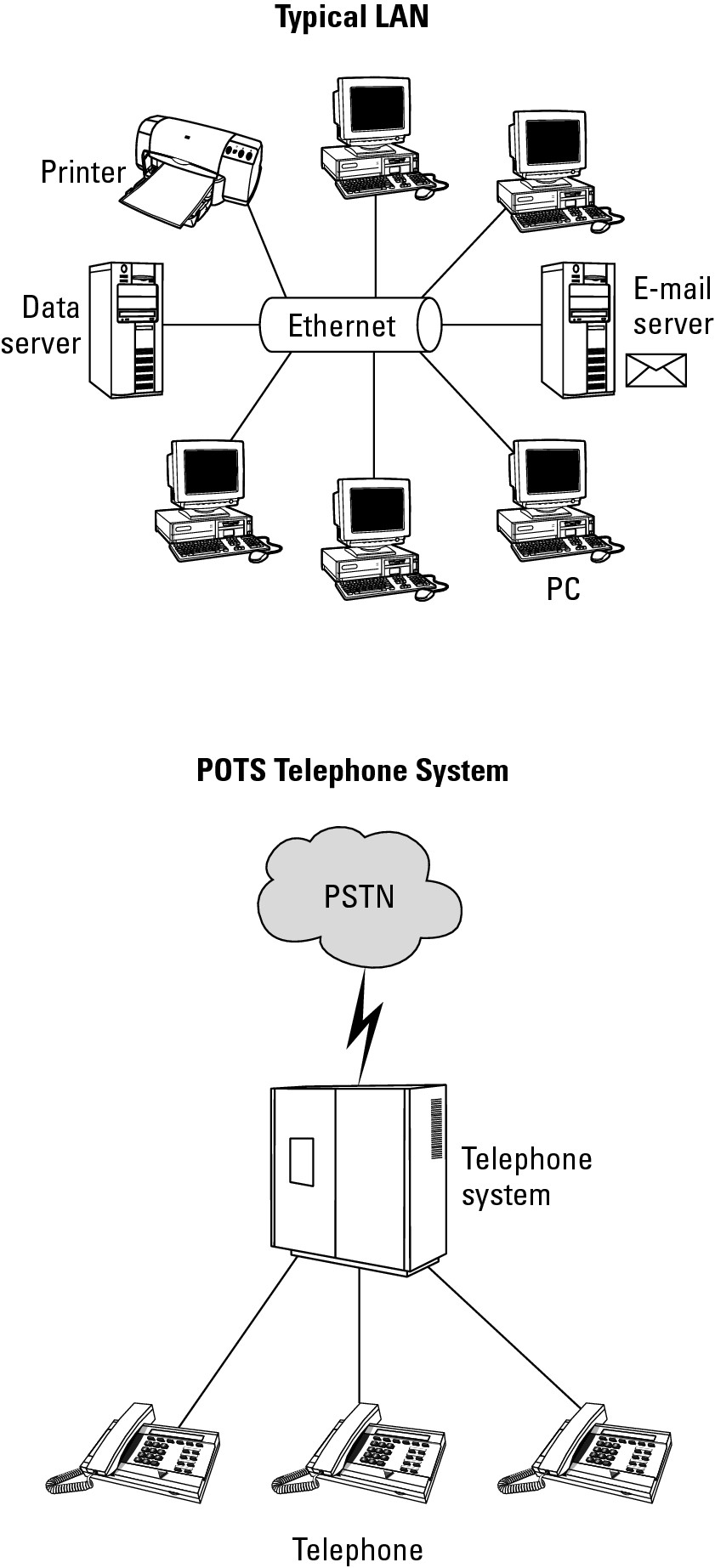
|
Private Telephone Systems Reduce POTS Line Costs
Computer data networks and circuit-switched voice networks are completely separate, with individual staffing, billing, maintenance, and accounting systems. Although the maintenance costs of computer networks are affordable for most companies, the recurring charges for traditional forms of telephony are huge for small, medium, and large multilocation companies. VoIP is designed to converge (integrate) a company’s voice needs onto the company’s existing computer network. If a company does this, they can eliminate most (if not all) recurring circuit-switched telephony charges.
In the past, the POTS world had only two types of services: local and long distance. Local service covered the entire metropolitan area, with no distinctions for the various levels of toll service that we have today. In the early days of the telephone, long-distance cost customers dearly. A call from New York to the west coast might have cost $3 to $4 per minute. Today, that same call might cost a consumer $.02 to $.05 per minute and a corporate caller $.01 to $.03 per minute. The corporate customer is most likely on some sort of dedicated private network consisting of a phone system connected to the PSTN.
It might appear that the cost of telephony today is dirt cheap in historical terms. This would be a mistaken conclusion. In addition to the carriers getting more organized and the government increasing its regulation of the telecommunications industry, many changes have evolved. These changes have increased your bottom-line telephone bill and increased the number of line items on that bill.
Now, instead of just two types of phone service offered on the PSTN (local and long distance), we have five: local, intralata, intrastate, interstate, and international. Each of these is discussed in detail in Chapter 3. These five services are based on the origin and destination of a call, using the LATA and NPA-NXX to determine those locations. In addition, the same system is used by the government to place various surcharges and fees on each telephone access line.
No one would argue that the quality of carrier-switched telephony is excellent. However, the system that has evolved for charging telephony customers leaves much unsaid and a lot to be desired. Except for local calling, VoIP can reduce or eliminate the charges of the other four categories.
To lessen the burden of newer and diverse telephone costs, many companies have acquired their own POTS-based telephone systems. Company-sponsored telephone systems can reduce the monthly bill that consumers and companies pay for telephony services. Four different telephony system models have evolved in the past three decades.
The first model, POTS, has already been described; it is the use of telephony access lines and carrier services over the PSTN through a carrier. The other models are the Centrex, KTS, and PBX models. Each of these are discussed in this sections.
The Centrex model
The second model is the central office exchange service, or Centrex, model. Centrex is physically set up the same as the POTS access line model. Like POTS, Centrex uses the same physical twisted-pair copper lines.
The difference between the POTS and Centrex models lies in how the line is terminated at the carrier company’s facility. Instead of getting switched into the PSTN directly, the Centrex line first goes to the more intelligent mainframe-level telephone system owned and operated by the carrier. From there, the system can provide the customer with many more features not directly available on a plain POTS line. To get these features on a POTS line, the customer typically has to pay for each feature. Centrex provides a bundle of features with little or no added charges.
Because you get more with Centrex, you pay a little more for the line on a per-line per-month basis. Centrex is a good alternative for companies operating out of temporary facilities (such as a lease situation) and for companies that can’t or don’t want to maintain a full-blown telecommunications infrastructure. When you lease a Centrex system, maintenance is usually included, which reduces the need for skilled staff on the company payroll. Figure 2-7 shows how the addition of a Centrex system modifies the model originally shown in Figure 2-1.
The good news is that a VoIP solution exists for the more traditional Centrex situation: VoIP Centrex. You need a computer network in the temporary premises, but that is an expense you can unplug and take with you when you move to your permanent location. With VoIP Centrex, you can start your VoIP network, acquire features galore, and get the maintenance services you need. When you move to your new, permanent location, you simply plug in your network, and you are up and running.
Figure 2-8 shows the addition of VoIP Centrex to the mix.
|
Figure 2-7: A typical Centrex telephone connection over a POTS line. |
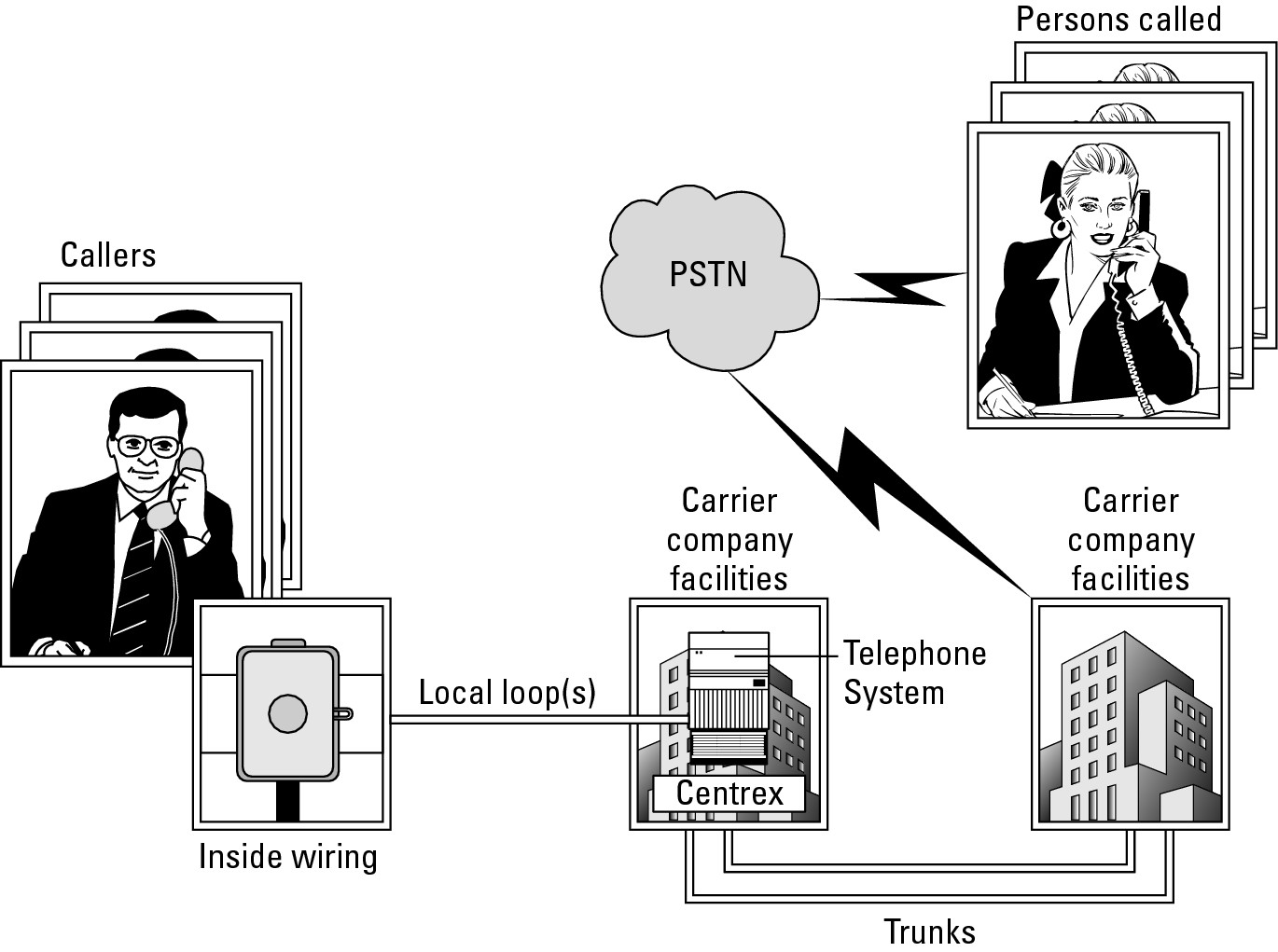
|
|
Figure 2-8: VoIP Centrex, sometimes called hosted VoIP. |
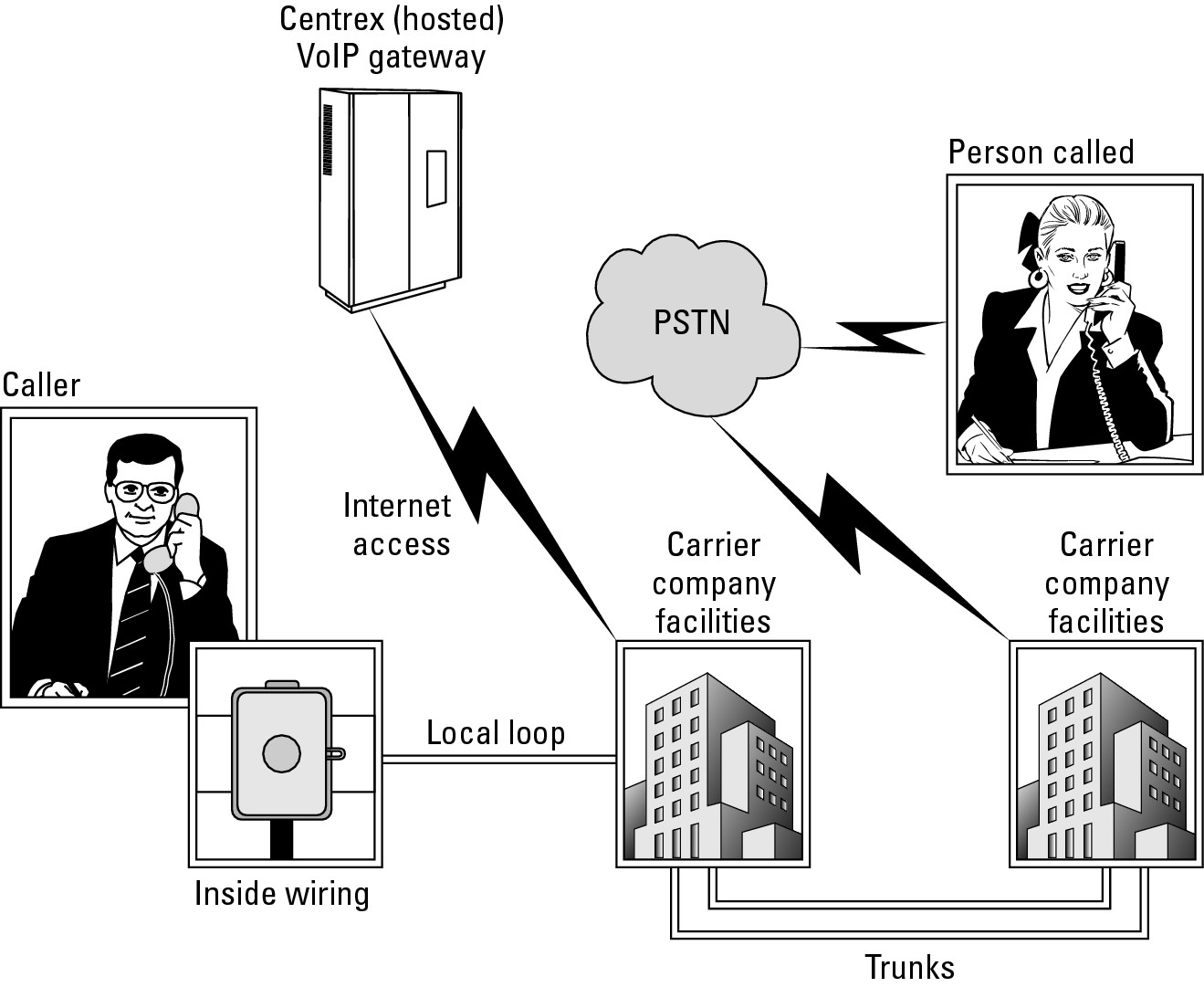
|
With any Centrex option, you pay more per month in return for avoiding the need to sink costs into your own infrastructure. Also, by using the Centrex host’s facilities, you get a rich feature set with no additional monthly charges. Another benefit is that you can walk away from a Centrex solution anytime you want without penalty. Although some smaller companies keep Centrex forever, most growing companies eventually convert to one of the models described in the following section.
The KTS and PBX models
The other two system models are private telephone systems installed on the company’s premises. Low-volume customers often use a key telephone system, or KTS. High-volume, larger companies often use a private branch exchange, or PBX. These two are a departure from the POTS-line model, where a line is run to each phone on the premises. As such, they are also a departure from the Centrex model, which uses the same type of access line as POTS.
Figure 2-9 illustrates how a typical private telephone system would change the phone mix.
|
Figure 2-9: A typical private telephone system connection. |
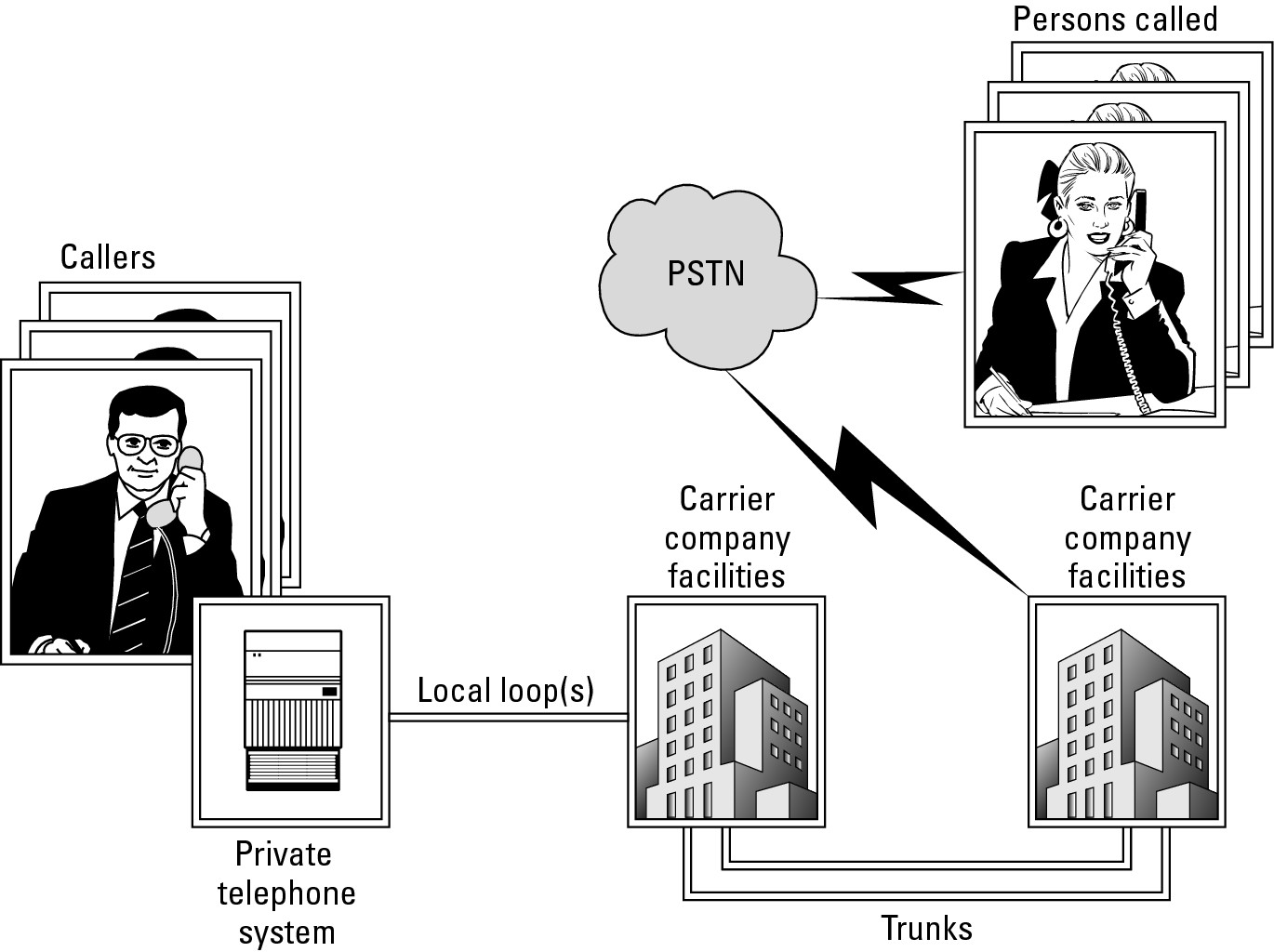
|
One big benefit of private telephone systems is that they reduce the number of required access lines. For example, the industry standard is one access line for every six to eight employees who have a telephone. Any reduction in the number of access lines represents an enormous cost benefit for companies when compared to the POTS or Centrex models. In addition, private telephone systems enable the company to provide most traditional call features, such as voice mail, call forwarding, call transfer, and conferencing, to any telephone in the company — at no added cost.
Private Systems versus VoIP
A private telephone system approach can’t begin to compare to a VoIP model in terms of savings. Your guide should be “How much telephone calling traffic, across all five regulated PSTN charging categories, do you or your company have each month?” If your monthly call volume, which is charged by the minute for each line across each charging category, is substantial, a private telephone system model reduces your recurring charges because you use fewer lines. However, VoIP can reduce your recurring charges even further, as you’ll discover in the next chapter.
Following is a list of cost benefits and features that your company can gain by converting to its own telephone system.
![]() Greatly reduced number of access lines
Greatly reduced number of access lines
![]() Reduced recurring carrier charges
Reduced recurring carrier charges
![]() Reduced access line fees and surcharges
Reduced access line fees and surcharges
![]() Reduced access line taxes
Reduced access line taxes
![]() Elimination of call feature charges
Elimination of call feature charges
![]() Greater managerial control of telephony systems and services
Greater managerial control of telephony systems and services
There is no doubt that moving to a private telephone system saves a company significant money when compared to a POTS access-line model. But keep in mind that all of these cost benefits are based on reductions in the number of lines required or lower costs for features priced on a per-line basis. These benefits are also realized with any VoIP model.
The conventional telephony models described in this section, KTS and PBX, don’t remove the problems associated with telephone costs. They only minimize them by adjusting the number of access lines or calling features you need to pay for. A VoIP system, on the other hand, represents a fundamental change in telephony, and thereby offers huge cost savings, feature enhancements, and productivity improvements. VoIP eliminates the need for most access lines. (A few POTS lines are always required in any building.) VoIP eliminates also the noncarrier costs (that is, your maintenance costs), line fees, and government surcharges that come with those lines. And VoIP runs on the computer network, which is usually already set up.
Converging Networks
In Figure 2-10, you see a packet-switched computer network running VoIP and connected to the traditional PSTN. Note the absence of any POTS lines or private telephone systems (KTS or PBX) under the DS carrier service network cloud. All telephone calls are originating on the company’s computer network using VoIP. Only calls destined for the PSTN are diverted off the company’s network. These types of calls, referred to as off-net, are the only calls that may be associated with a recurring service charge. For customers and companies running VoIP, off-net calls typically are only the calls that go to the public network (for example, to order a pizza or to call 911). On-net calls require no additional lines over the existing computer network setup and, unlike POTS-PSTN calling, have no additional recurring charges.
|
Figure 2-10: VoIP connecting to private and public networks. |
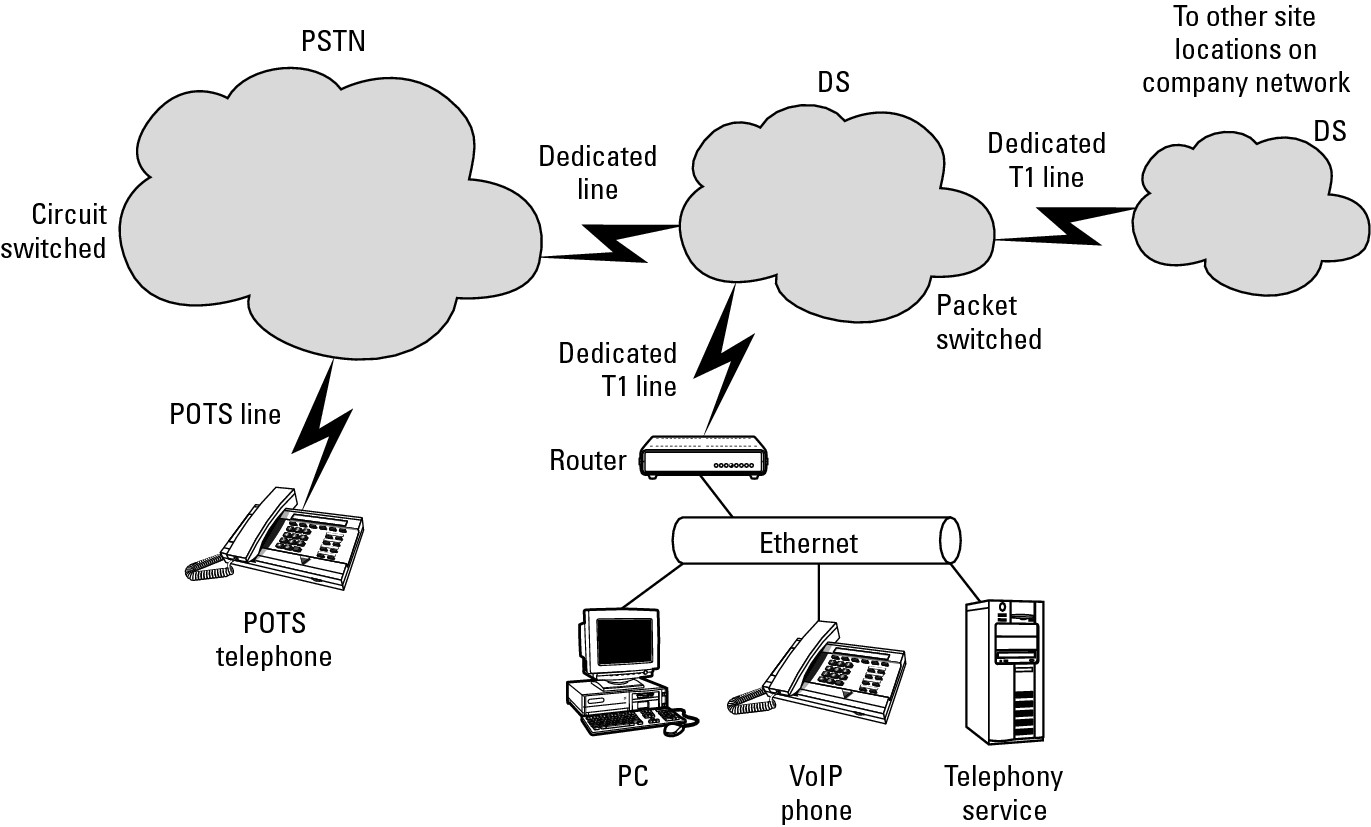
|
A smaller company with just a single location may use VoIP to connect their computer network to the PSTN to support calls that must travel off their private network. This solution requires installing a VoIP gateway that can convert the company’s on-net traffic to circuit-switched telephone calls that have an off-net destination. For example, a call from your desktop phone to the grade school that your daughter attends is likely to be a local PSTN call. Figure 2-11 shows how a VoIP network works with a gateway.
|
Figure 2-11: Adding a PSTN gateway to a VoIP network. |
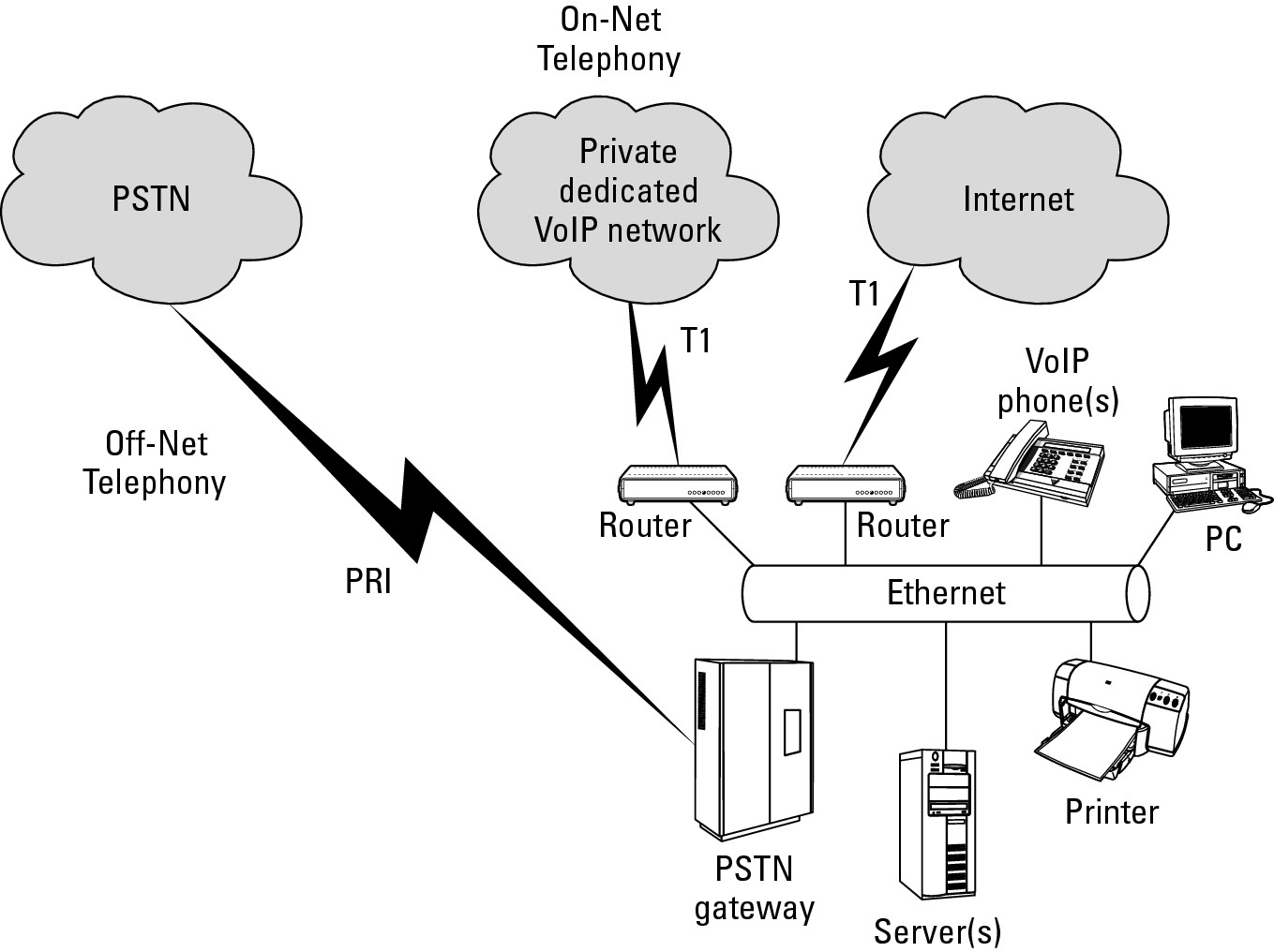
|
Converting VoIP telephony traffic to run on the PSTN is certainly a big benefit of VoIP, but many more exciting features and benefits are explained in the chapters that follow. For example, in Chapter 3, I describe how VoIP reduces or eliminates those nasty, pay-by-the-minute service charges and other recurring charges such as regulatory fees and taxes.
